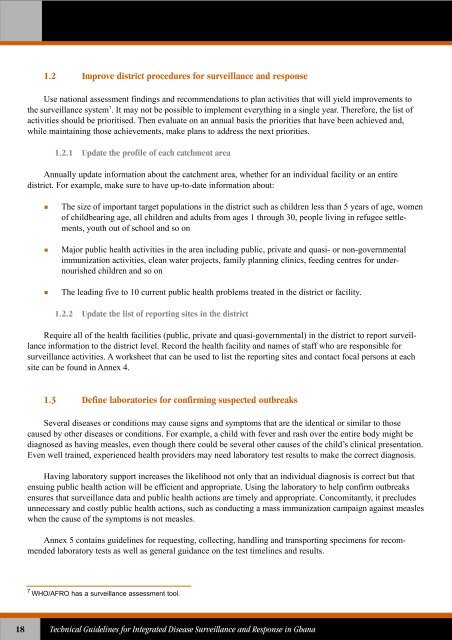Technical Guidelines for Integrated Disease Surveillance ... - PHRplus
Technical Guidelines for Integrated Disease Surveillance ... - PHRplus
Technical Guidelines for Integrated Disease Surveillance ... - PHRplus
Create successful ePaper yourself
Turn your PDF publications into a flip-book with our unique Google optimized e-Paper software.
1.2 Improve district procedures <strong>for</strong> surveillance and responseUse national assessment findings and recommendations to plan activities that will yield improvements tothe surveillance system 7 . It may not be possible to implement everything in a single year. There<strong>for</strong>e, the list ofactivities should be prioritised. Then evaluate on an annual basis the priorities that have been achieved and,while maintaining those achievements, make plans to address the next priorities.1.2.1 Update the profile of each catchment areaAnnually update in<strong>for</strong>mation about the catchment area, whether <strong>for</strong> an individual facility or an entiredistrict. For example, make sure to have up-to-date in<strong>for</strong>mation about:The size of important target populations in the district such as children less than 5 years of age, womenof childbearing age, all children and adults from ages 1 through 30, people living in refugee settlements,youth out of school and so onMajor public health activities in the area including public, private and quasi- or non-governmentalimmunization activities, clean water projects, family planning clinics, feeding centres <strong>for</strong> undernourishedchildren and so onThe leading five to 10 current public health problems treated in the district or facility.1.2.2 Update the list of reporting sites in the districtRequire all of the health facilities (public, private and quasi-governmental) in the district to report surveillancein<strong>for</strong>mation to the district level. Record the health facility and names of staff who are responsible <strong>for</strong>surveillance activities. A worksheet that can be used to list the reporting sites and contact focal persons at eachsite can be found in Annex 4.1.3 Define laboratories <strong>for</strong> confirming suspected outbreaksSeveral diseases or conditions may cause signs and symptoms that are the identical or similar to thosecaused by other diseases or conditions. For example, a child with fever and rash over the entire body might bediagnosed as having measles, even though there could be several other causes of the child’s clinical presentation.Even well trained, experienced health providers may need laboratory test results to make the correct diagnosis.Having laboratory support increases the likelihood not only that an individual diagnosis is correct but thatensuing public health action will be efficient and appropriate. Using the laboratory to help confirm outbreaksensures that surveillance data and public health actions are timely and appropriate. Concomitantly, it precludesunnecessary and costly public health actions, such as conducting a mass immunization campaign against measleswhen the cause of the symptoms is not measles.Annex 5 contains guidelines <strong>for</strong> requesting, collecting, handling and transporting specimens <strong>for</strong> recommendedlaboratory tests as well as general guidance on the test timelines and results.7 WHO/AFRO has a surveillance assessment tool.18<strong>Technical</strong> <strong>Guidelines</strong> <strong>for</strong> <strong>Integrated</strong> <strong>Disease</strong> <strong>Surveillance</strong> and Response in Ghana















